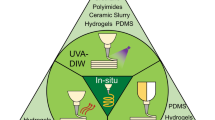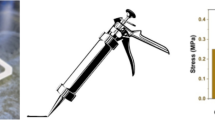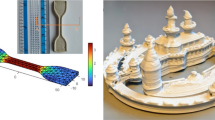Abstract
Direct Ink Writing (DIW) is a promising 3D printing method for controlled multi-material deposition to make well-defined geometrical structures. Stringent rheological requirements enable the additive build-up of extruded layers. Although commercially available, no occasion has been reported on poly(butyl vinyl ether) adhesives for DIW. The moisture curing mechanism and thixotropic build-up indicate an alternative route to cross-linking curing to thermoset elastomers. Chemical composition and rheological characterizations were conducted to evaluate printability and physicochemical properties (i.e., dielectric properties, thermal conductivity, etc.) to address the potential for further reformulation and study with nanomaterial additives.
Graphical abstract





Similar content being viewed by others
Data availability
All data for the work is either included in this manuscript or is part of the Electronic Supplementary Information (SI) file that will be publicly available.
Change history
16 November 2023
A Correction to this paper has been published: https://doi.org/10.1557/s43579-023-00496-2
References
M.A.S.R. Saadi, A. Maguire, N.T. Pottackal, M.S.H. Thakur, M.M. Maruf, A.J. Hart, P.M. Ajayan, M.M. Rahman, Direct ink writing: a 3D printing technology for diverse materials. Adv. Mater. 34, 2108855 (2022). https://doi.org/10.1002/adma.202108855
D.S. Shah, B.K. Lawson, M. Yaszemski, Description and Definition of Adhesives, and Related Terminology, in Biomaterials Science. (Academic Press, Cambridge, 2020)
“Elastomeric Systems,” Master Bond Elastomeric Adhesives and Sealants | MasterBond.com. https://www.masterbond.com/products/elastomeric-systems. Accessed 07 Mar 2023
S. Rouif, Radiation cross-linked polymers: Recent developments and new applications. Nucl Instrum Methods Phys Res Sect B: Beam Interact Mater Atoms 236(1–4), 68–72 (2005). https://doi.org/10.1016/j.nimb.2005.03.252
NovaBond textured hybrid construction sealant specification data. https://novagard.com/wp-content/uploads/dlm_uploads/2022/08/TDS-NBT-NovaBond-TEXTURED-Hybrid-Construction-Sealant-v1.8.pdf. Accessed 07 Mar 2023
“Safety data sheet - gorilla construction adhesive.” https://www.gorillatough.com/wp-content/uploads/Gorilla-Construction-Adhesive.pdf. Accessed 07 Mar 2023
POLYVINYL ETHERS (PVE), Properties of polyvinyethers. https://polymerdatabase.com/polymer%20classes/Polyvinylether%20type.html. Accessed 07 Mar 2023
H. Nakata, S. Murata, J. Filatreau, Occurrence and concentrations of benzotriazole UV stabilizers in marine organisms and sediments from the Ariake Sea, Japan. Environ. Sci. Technol. 43(18), 6920–6926 (2009). https://doi.org/10.1021/es900939j
Libretexts, “Infrared spectroscopy absorption table,” Chemistry LibreTexts, Accessed 03 Nov 2020
E. Herth, R. Zeggari, J.-Y. Rauch, F. Remy-Martin, W. Boireau, Investigation of amorphous SiOx layer on gold surface for Surface Plasmon Resonance measurements. Microelectron. Eng. (2016). https://doi.org/10.1016/j.mee.2016.04.014
Everkem Products. Introduction to MS Polymer Hybrid Sealants and Adhesives.Available: https://everkemproducts.com/introduction-to-ms-polymer-hybrid-sealants-and-adhesives/. Accessed 17 May 2023
Y. Sainohira, K. Fujino, A. Shimojima et al., Preparation of CO2-adsorbable amine-functionalized polysilsesquioxanes containing cross-linked structures without using surfactants and strong acid or base catalysts. J. Sol-Gel Sci. Technol. 91, 505–513 (2019). https://doi.org/10.1007/s10971-019-05072-6
K. Saido, H. Taguchi, S. Yada et al., Thermal decomposition products of phthalates with poly(vinyl chloride) and their mutagenicity. Macromol. Res. 11, 178–182 (2003). https://doi.org/10.1007/BF03218349
T.O. Bamkole, E.U. Emovon, The thermal decomposition of n-butyl vinyl ether. Part I. The inhibited reaction. J. Chem. Soc. B (1967). https://doi.org/10.1039/J29670000523
K.S.P. Karunadasa, C.H. Manoratne, H.M.T.G.A. Pitawala, R.M.G. Rajapakse, Thermal decomposition of calcium carbonate (calcite polymorph) as examined by in-situ high-temperature X-ray powder diffraction. J. Phys. Chem. Solids 134, 21–28 (2019). https://doi.org/10.1016/j.jpcs.2019.05.023
D. Kuckling, A. Doering, F. Krahl, K.-F. Arndt, Stimuli-Responsive Polymer Systems, in Polymer Science A Comprehensive Reference. (Elsevier, Amsterdam, 2012)
Z. Xu, S. Zheng, X. Wu, Z. Liu, R. Bao, W. Yang, M. Yang, High actuated performance MWCNT/Ecoflex dielectric elastomer actuators based on layer-by-layer structure. Compos. Part A: Appl. Sci. Manuf. (2019). https://doi.org/10.1016/j.compositesa.2019.105527
“Dissipation factor,” Dissipation Factor (DF) of Plastics - Unit, Formula and Measurement. https://omnexus.specialchem.com/polymer-properties/properties/dissipation-factor. Accessed 07 Mar 2023
X. Yu, B. Yi, F. Liu, X. Wang, Prediction of the dielectric dissipation factor tanδ of polymers with an ANN model based on the DFT calculation. React. Funct. Polym. 68(11), 1557–1562 (2008). https://doi.org/10.1016/j.reactfunctpolym.2008.08.009
L.W. McKeen, Chapter 2 - Introduction to the Properties of Plastic and Elastomer Films, in Plastics Design Library, Film Properties of Plastics and Elastomers. ed. by L.W. McKeen (William Andrew Publishing, Norwich, 2012)
N.G. Parsonage, Chapter 6 - Thermal Conductivity, in The Commonwealth and International Library: Chemistry Division, The Gaseous State. ed. by N.G. Parsonage (Elsevier, Amsterdam, 1966)
M.P. Jahan, M. Rahman, Y.S. Wong, Micro-Electrical Discharge Machining (Micro-EDM): Processes, Varieties, and Applications, in Comprehensive Materials Processing. (Elsevier, Amsterdam, 2014)
F. Elahee, L. Rong, C. Breting, J. Bonilla-Cruz, T. Ceniceros, Z. Smith, J. Ge, X. Cheng, M. Xu, M. Yang, E. Ribeiro, E. Caldona, R. Advincula, Acrylic sealants as practicable direct ink writing (DIW) 3D-printable materials. MRS Commun. 13, 299–305 (2023). https://doi.org/10.1557/s43579-023-00343-4
A. Espera, J. Dizon, A. Valino, Q. Chen, I. Silva, S. Nguyen, L. Rong, R. Advincula, On the 3D printability of silicone-based adhesives via viscous paste extrusion. MRS Commun. (2023). https://doi.org/10.1557/s43579-022-00318-x
D. Gutierrez, E. Caldona, Z. Yang, X. Suo, X. Cheng, S. Dai, R. Espiritu, R. Advincula, 3D-printed PDMS-based membranes for CO2 separation applications. MRS Commun. (2022). https://doi.org/10.1557/s43579-022-00287-1
A. Stephen, S. Bhoyate, P. Cao, R. Advincula, N. Dahotre, Y. Jiang, W. Choi, 3D-printed flexible anode for high-performance zinc ion battery. MRS Commun. 12, 894–901 (2022). https://doi.org/10.1557/s43579-022-00267-5
R. Advincula, J. Dizon, E. Caldona, R. Viers, F. Siacor, R. Maalihan, A. Espera, On the progress of 3D-printed hydrogels for tissue engineering. MRS Commun. 8(3), 1–15 (2021). https://doi.org/10.1557/s43579-021-00069-1
W. Niu, Z. Zhang, Q. Chen, P.-F. Cao, R. Advincula, Highly recyclable, mechanically isotropic and healable 3D-printed elastomers via Polyurea vitrimers. ACS Mater. Lett. 3(8), 1095–1103 (2021). https://doi.org/10.1021/acsmaterialslett.1c00132
F. Siacor, Q. Chen, J. Zhao, L. Han, A. Valino, E. Taboada, E. Caldona, R. Advincula, On the additive manufacturing (3D Printing) of viscoelastic materials and flow behavior: from composites to food manufacturing. Addit. Manuf. 5(23), 102043 (2021). https://doi.org/10.1016/j.addma.2021.102043
Q. Chen, J. Zhao, J. Ren, L. Rong, P.-F. Cao, R. Advincula, 3D printed multifunctional, hyperelastic silicone rubber foam. Adv. Func. Mater. 29(23), 1900469 (2019). https://doi.org/10.1002/adfm.201900469
A. Jurago, R. Viers, A. Nguyen, E. Ribeiro, A. Espera Jr., E. Caldona, R. Advincula, On the 3D printing of polyelectrolyte complexes: a novel approach to overcome rheology constraints. MRS Commun. (2023). https://doi.org/10.1557/s43579-023-00415-5
C. Nocheseda, G. Elahee, M. Santos, X. Cheng, R. Espera, R. Advincula, On the 3D printability of one-part moisture-curable polyurethanes via direct ink writing (DIW). MRS Commun. 13, 647–656 (2023). https://doi.org/10.1557/s43579-023-00407-5
M. Islam, R. Rupom, P. Adhikari, Z. Demchuk, I. Popov, A. Sokolov, F. Wu, R. Advincula, N. Dahotre, Y. Jiang, W. Choi, Boosting piezoelectricity by 3D printing PVDF-MoS2 composite as a conformal and high-sensitivity piezoelectric sensor. Adv. Funct. Mat. 5, 2–6 (2023). https://doi.org/10.1002/adfm.202302946
M. Espino, B. Tuazon, A. Espera Jr., C. Nocheseda, R. Manalang, J. Dizon, R. Advincula, Statistical methods for design and testing of 3D-printed polymers. MRS Commun. 13, 193–211 (2023). https://doi.org/10.1557/s43579-023-00332-7
Acknowledgments
We acknowledge technical support from Frontier Laboratories and Quantum Analytics. This work (or part of this work) was conducted in Oak Ridge National Laboratory Center for Nanophase Materials Sciences (CNMS) by R C Advincula. CNMS is a US Department of Energy Office of Science User Facility.
Funding
Basic Energy Sciences.
Author information
Authors and Affiliations
Corresponding author
Ethics declarations
Conflict of interest
There are no conflicts to declare.
Additional information
Publisher's Note
Springer Nature remains neutral with regard to jurisdictional claims in published maps and institutional affiliations.
Rigoberto Advincula was an editor of this journal during the review and decision stage. For the MRS Communications policy on review and publication of manuscripts authored by editors, please refer to http://www.mrs.org/editormanuscripts/.
This article was updated to correct reference 32. The title of the cited article was truncated.
Supplementary Information
Below is the link to the electronic supplementary material.
Rights and permissions
Springer Nature or its licensor (e.g. a society or other partner) holds exclusive rights to this article under a publishing agreement with the author(s) or other rightsholder(s); author self-archiving of the accepted manuscript version of this article is solely governed by the terms of such publishing agreement and applicable law.
About this article
Cite this article
Nguyen, A., Elahee, G.M.F., Cheng, X. et al. Formulated poly (butyl vinyl ether) adhesives as alternative materials for direct ink writing (DIW) 3D printing. MRS Communications 13, 1407–1415 (2023). https://doi.org/10.1557/s43579-023-00477-5
Received:
Accepted:
Published:
Issue Date:
DOI: https://doi.org/10.1557/s43579-023-00477-5




